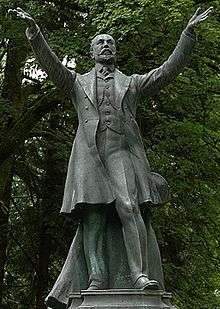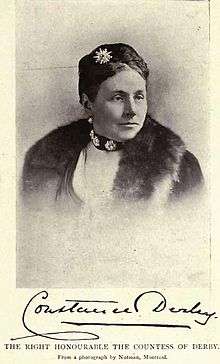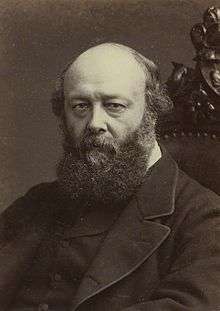Frederick Stanley, 16th Earl of Derby
| The Right Honourable The Earl of Derby KG GCB GCVO PC | |
|---|---|
 | |
| 6th Governor General of Canada | |
|
In office 11 June 1888 – 18 September 1893 | |
| Monarch | Queen Victoria |
| Prime Minister |
Canadian: John A. Macdonald John Abbott John Thompson British: Marquess of Salisbury William Ewart Gladstone |
| Preceded by | The Marquess of Lansdowne |
| Succeeded by | The Earl of Aberdeen |
| President of the Board of Trade | |
|
In office 3 August 1886 – 21 February 1888 | |
| Monarch | Victoria |
| Prime Minister | The Marquess of Salisbury |
| Preceded by | A. J. Mundella |
| Succeeded by | Sir Michael Hicks Beach, Bt |
| Secretary of State for the Colonies | |
|
In office 24 June 1885 – 28 January 1886 | |
| Monarch | Victoria |
| Prime Minister | The Marquess of Salisbury |
| Preceded by | The Earl of Derby |
| Succeeded by | The Earl Granville |
| Secretary of State for War | |
|
In office 2 April 1878 – 21 April 1880 | |
| Monarch | Victoria |
| Prime Minister | The Earl of Beaconsfield |
| Preceded by | Gathorne Hardy |
| Succeeded by | Hugh Childers |
| Personal details | |
| Born |
15 January 1841 London, United Kingdom |
| Died |
14 June 1908 (aged 67) Holwood, Kent, United Kingdom |
| Nationality |
British Canadian |
| Political party | Conservative |
| Spouse(s) |
Lady Constance Villiers (1840–1922) |
| Children |
Isobel Stanley (1875–1963) |
| Alma mater |
Eton Royal Military College, Sandhurst |
| Signature |
 |
| Military service | |
| Allegiance |
|
| Service/branch |
|
| Years of service | 1862–1865 |
| Rank | Captain |
| Unit | Grenadier Guards |
Frederick Arthur Stanley, 16th Earl of Derby KG GCB GCVO PC (15 January 1841 – 14 June 1908), known as Frederick Stanley until 1886 and as Lord Stanley of Preston between 1886 and 1893, was a Conservative Party politician in the United Kingdom who served as Colonial Secretary from 1885 to 1886 and the sixth Governor General of Canada from 1888 to 1893. An avid sportsman, he built Stanley House Stables in England, and is famous in North America for presenting Canada with the Stanley Cup. Stanley was also one of the original inductees of the Hockey Hall of Fame.
Background and education
Derby was the second son of Prime Minister Edward Smith-Stanley, 14th Earl of Derby, and the Hon. Emma Caroline, daughter of Edward Bootle-Wilbraham, 1st Baron Skelmersdale. He was born in London and was educated at Eton and Sandhurst. He received a commission in the Grenadier Guards, rising to the rank of Captain.[1]
Political career
Derby left the army for politics, serving as a Conservative Member of Parliament (for Preston from 1865 to 1868, North Lancashire from 1868 to 1885 and Blackpool from 1885 to 1886). In government, he served as a Civil Lord of the Admiralty (1868), Financial Secretary to the War Office (1874–1878), Secretary to the Treasury (1878), War Secretary (1878–1880) and Colonial Secretary (1885–1886).[1] In 1886 he was created Baron Stanley of Preston, in the County Palatine of Lancaster. He served as President of the Board of Trade (1886–1888), remaining in that office until he was appointed Governor General of Canada.[1]
Governor General of Canada
Stanley was appointed the Governor General of Canada and Commander in Chief of Prince Edward Island on 1 May 1888.[1] During his term as Governor General, he travelled often and widely throughout the country. His visit to western Canada in 1889 gave him a lasting appreciation of the region's great natural beauty as well as permitting him to meet the people of Canada's First Nations and many western ranchers and farmers. During his visit he dedicated Stanley Park, which is named after him. He also experienced the joys of fishing and avidly pursued the sport whenever his busy schedule allowed. As governor general, Derby was the third holder of that office to whom Queen Victoria granted the power of granting pardons to offenders or remitting sentences and fines and the power of mitigating capital or any other sentence.[1]
When Sir John A. Macdonald died in office of heart failure on 6 June 1891, Derby lost the close friendship he had enjoyed with the Prime Minister. He asked Sir John Abbott to take over as prime minister. Once the government was in place, Abbott resigned for health reasons and turned the government over to Sir John Thompson. Derby helped cement the non-political role of the governor general when, in 1891, he refused to agree to a controversial motion in the House of Commons. The motion called on him as governor general to disallow the government of Quebec's Jesuit Estates Act, which authorized paying $400,000 as compensation for land granted to the Jesuits by the King of France.[1] The opposition to the bill was introduced by the other provinces who were motivated by mistrust of the Roman Catholic Church in Quebec. Derby declined to interfere, citing the proposed disallowal as unconstitutional. In holding to this decision, he gained popularity by refusing to compromise the viceregal position of political neutrality.
Derby's wife, whom Sir Wilfrid Laurier described as "an able and witty woman", made a lasting contribution during her husband's term of office. In 1891, she founded the Lady Stanley Institute for Trained Nurses on Rideau Street, the first nursing school in Ottawa. She was also an enthusiastic fan of hockey games at the Rideau Rink.
Stanley Cup

Derby's sons became avid ice hockey players in Canada, playing in amateur leagues in Ottawa, and Lord and Lady Derby became staunch hockey fans. In 1892, Derby gave Canada a treasured national icon, the Stanley Cup. He originally donated the trophy as a challenge cup for Canada's best amateur hockey club, but in 1909, it became contested by professional teams exclusively. Since 1926, only teams of the National Hockey League have competed for the trophy. This now famous cup bears Derby's name as tribute to his encouragement and love of outdoor life and sport in Canada. In recognition of this, Derby was inducted into the Canadian Hockey Hall of Fame in 1945 in the "Honoured Builders" category. The original size of the Stanley Cup was 7 inches (180 mm) and is now around 36 inches (910 mm) and 35 pounds (16 kg).
Later years

Derby's term as Governor General of Canada was due to end in September 1893. However, in April of that year, his elder brother, the 15th Earl of Derby, died. Stanley succeeded him as the 16th Earl of Derby. As a result, he left Canada on 15 July 1893 and returned to England. An administrator was appointed to fulfil his duties until Lord Aberdeen was sworn in that September.
Also in 1893, Toronto's "New Fort York" (built in 1841) was renamed The Stanley Barracks in Honour of Lord Stanley. Back with his family in England, he soon became the Lord Mayor of Liverpool and the first Chancellor of the University of Liverpool, Stanley Park, Liverpool is also named after him. In November 1901 Lord Derby was elected Mayor of Preston for the following year,[3] and took part in the 1902 Preston Guild. During the last years of his life, he increasingly dedicated himself to philanthropic work. He helped fund the Coronation Park, Ormskirk, in 1905.[4]
With the possible exception of recordings of Thomas Alva Edison's own voice, a recording of Lord Stanley in 1888 may be the oldest known recording of a human voice to still exist.
Family


Lord Derby married Lady Constance Villiers, daughter of George Villiers, 4th Earl of Clarendon, K.G., G.C.B., on 31 May 1864.[1] She was born in 1840. They had eight sons and two daughters (of whom one son and one daughter died as children). Her Ladyship remained and several of their children lived in Canada throughout his term as Governor General. She was responsible for the foundation of the Lady Stanley Institute for Trained Nurses in Ottawa, Ontario, as well as a Maternity Hospital. She was president of the $4,000 fund instituted by the women of Canada for the presentation of a wedding gift to the present Prince and Princess of Wales: a sleigh, robes, harness and horses and a canoe. In 1890 Prince George of Wales, later Prince of Wales was their guest at Rideau Hall. In 1903 King Edward VII was their guest at their residence, St. James Square, London, England.
Their second son the Hon. Sir Victor Stanley, R.N. (1867–1934) was an Admiral in the Royal Navy who married a Canadian lady, the daughter of Hon. C. E. Pooley, K.C., of British Columbia.[5] Their third son the Hon. Sir Arthur Stanley and sixth son the Hon. Sir George Frederick Stanley were both politicians. Their fourth son Ferdinand Charles Stanley was educated at Wellington and Sandhurst, before joining the King's Royal Rifle Corps in 1891, rising to the rank of Brigadier-General. He married Alexandra, the eldest daughter of the Baron de Ramsey; they lived at 8 Cornwall Terrace, Regent's Park, London, now renamed Stanley House.[6]
Their daughter Lady Isobel Gathorne-Hardy née Isobel Stanley was their longest living child living until 1963. She was instrumental in convincing her father to create the Stanley Cup.[7] She is mentioned in one of the first games of women's hockey, played at Rideau Skating Rink in 1899. Her role as a women's hockey pioneer is recognized in women's hockey with both with the Isobel Gathorne-Hardy Award given across women's hockey in Canada and the Isobel Cup, the National Women's Hockey League's championship trophy.
Lord Stanley died 14 June 1908, aged 67, and was succeeded by his eldest son Edward, who also became a distinguished politician. Lady Constance died on 17 April 1922.
Legacy
After Edward Whymper made the first ascent of Stanley Peak in 1901, he named the mountain after Lord Derby. Vancouver's Stanley Park and Stanley Theatre were also named after him,[8] as was Stanley Park, Blackpool.
The Preston Squadron of cadets at the Royal Military College Saint-Jean was named in his honour. The Stanley Cup awarded to the winning team of the NHL playoffs each season was named in his honour. Stanley Park, an area that famously separates the home grounds of English Premier League football teams Liverpool F. C. and Everton F. C., was named after him.
Stanley House Inn, named for Lord Stanley and was built as his summer residence in 1888 along the Cascapedia River.
Honorary degrees
 Queen's University in Kingston, Ontario (LL.D) in 1889[9]
Queen's University in Kingston, Ontario (LL.D) in 1889[9]
Honorific eponyms
- Stanley, New Brunswick
- Stanley, Nova Scotia
- Port Stanley, Ontario
- Stanley Park, Vancouver, British Columbia
- Stanley Peak (Ball Range) (British Columbia)[10][11][12]
- Rue Stanley, Montréal, Québec[13]
- Stanley Avenue, Victoria, British Columbia
- Stanley Street, Brisbane, Queensland
- Stanley Street, Townsville, Queensland
See also
Notes
- 1 2 3 4 5 6 7 "Canada's Executive Head; Power and Emoluments of the Governor General. Almost Unlimited Authority Granted to Him – An Expensive Luxury for Canadians Who Want to Choose Their Own Governor," New York Times. 5 November 1891.
- ↑ Grand Lodge of British Columbia and Yukon: A few famous freemasons.
- ↑ "Election of Mayors". The Times (36609). London. 11 November 1901. p. 7.
- ↑ Broady-Hawkes, Dot (21 June 2015). "Ormskirk Nostalgia: Happy birthday to Coronation Park - 120 years old this month". Southport Visitor.
- ↑ https://archive.org/details/typesofcanadianw01morguoft Morgan, Henry James Types of Canadian women and of women who are or have been connected with Canada:(Toronto, 1903)
- ↑ "Cornwall Terrace".
- ↑ "Biographies". CBC.ca. Retrieved September 29, 2009.
- ↑ Mathison, Emily. "Things That Go Bump in the Night: Unearthly spirit sightings at a local landmark" Retrieved on 9 May 2008.
- ↑ http://www.queensu.ca/secretariat/HDrecipients.pdf
- ↑ "Stanley Peak British Columbia #1538". Bivouac.com. Retrieved 12 June 2012.
- ↑ Peakware.com (ed.). "Stanley Peak". Peakware World Mountain Encyclopedia. Retrieved 12 June 2012.
- ↑ "Peak Stanley". Peakfinder.com. Retrieved 12 June 2012.
- ↑ Stanley Street (Montreal)
References
External links
| Wikimedia Commons has media related to Frederick Stanley, 16th Earl of Derby. |
- Hansard 1803–2005: contributions in Parliament by the Earl of Derby
- Website of the Governor General of Canada
- Lord Stanley's biography at Legends of Hockey
- Lord Stanley At Find A Grave
- Lord Stanley's Glacier hike
- Photograph: Lord Stanley in 1889. McCord Museum
- Photograph: Lord Stanley in 1889. McCord Museum
- Photograph: His Excellency Lord Stanley and snowshoes in 1890. McCord Museum
